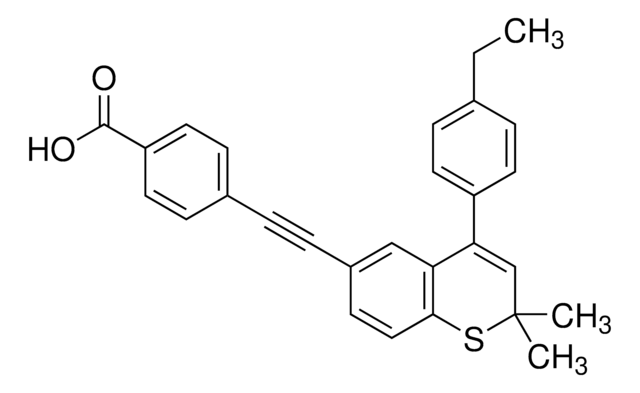SML0921
AR7
≥98% (HPLC)
Sinonimo/i:
7-Chloro-3-(4-methylphenyl)-2H-1,4-benzoxazine; 7-Chloro-3-p-tolyl-2H-benzo[b][1,4]oxazine, Atypical retinoid 7
About This Item
Prodotti consigliati
Livello qualitativo
Saggio
≥98% (HPLC)
Forma fisica
powder
Colore
white to beige
Solubilità
DMSO: 20 mg/mL, clear
Temperatura di conservazione
2-8°C
Applicazioni
- as chaperone-mediated autophagy (CMA) activator to study the activity of CMA in rat liver lysosomes
- as a CMA activator to study its effects on expression of DEAD-box helicase 3 X-linked (DDX3X), eukaryotic translation initiation factor 4A1 (EIF4A1), and eukaryotic translation initiation factor 4H (EIF4H) in cancer cells
- to study its effects on synuclein α (SNCA) oligomer levels in mature primary cortical neurons
Azioni biochim/fisiol
Avvertenze
Warning
Indicazioni di pericolo
Consigli di prudenza
Classi di pericolo
Aquatic Acute 1 - Aquatic Chronic 1
Codice della classe di stoccaggio
11 - Combustible Solids
Classe di pericolosità dell'acqua (WGK)
WGK 3
Punto d’infiammabilità (°F)
Not applicable
Punto d’infiammabilità (°C)
Not applicable
Certificati d'analisi (COA)
Cerca il Certificati d'analisi (COA) digitando il numero di lotto/batch corrispondente. I numeri di lotto o di batch sono stampati sull'etichetta dei prodotti dopo la parola ‘Lotto’ o ‘Batch’.
Possiedi già questo prodotto?
I documenti relativi ai prodotti acquistati recentemente sono disponibili nell’Archivio dei documenti.
Il team dei nostri ricercatori vanta grande esperienza in tutte le aree della ricerca quali Life Science, scienza dei materiali, sintesi chimica, cromatografia, discipline analitiche, ecc..
Contatta l'Assistenza Tecnica.









